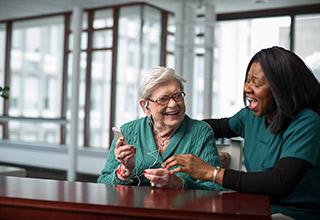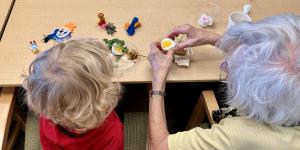Gait and Walking Speed as a Predictor of Health
What does how we walk tell us about current health and future outcomes?

What are good indicators for someone’s health? While we often think of vital signs like blood pressure and heartbeat, those are not the only ways to help gauge overall health. As the Director of Rehabilitation Services at Hebrew Rehabilitation Center, my work involves a measurement that we use every day, but you might not think of.
Walking speed—or gait speed— is a useful metric for measuring current health and predicting health outcomes in the future. In fact, walking speed has been coined as the sixth vital sign as it can be used to gauge patient function, illness, degree of dependence, and ability to perform activities of daily living like bathing, eating, and getting in and out of bed.
Furthermore, it can help us target areas of concern for current treatment while anticipating future medical needs. Improved gait speed can be linked to meaningful changes in quality of life.
What is gait speed?
Gait speed is the time one takes to walk a specific, short distance on level surfaces. It is not a measure of endurance, but rather a test of someone’s functional mobility - a person’s physiological ability to move independently and safely in the environment.
Normal walking speed primarily involves the lower extremities, with the arms and trunk providing stability and balance. Walking at faster speeds relies on your upper extremities and trunk for extra propulsion, balance, and stability with the lower limb joints producing greater ranges of motion.
What can gait speed predict about a person’s health?
Safe walking requires intact cognition and executive control. You might not realize it, but every step you take is a complicated balancing act as your bodyweight shifts from side to side, and your brain processes the information it receives from your body moving through all different types of environments. Because the process of walking involves coordination between different systems of the body including the nervous, musculoskeletal, and cardiorespiratory systems, gait speed is a sensitive marker of general health and survival.
We use research-based standards based on age to evaluate a person’s gait speed. It can also be helpful to look at how a person’s gait speed changes over time - a decrease from one year to the next is a sign that there may be an underlying condition that needs further exploration or treatment.
Slower speed indicates an increased risk of fall and injury and can predict future disability, dementia, hospitalization, and even death. In fact, one study showed that slower gait speed in an older adult predicts their likelihood of needing help bathing or dressing, mobility difficulty, disability, and mortality within the next three years.
Such problems will ultimately lead to a loss of independence and quality of life. If someone is struggling to walk, it’s logical to conclude they will face challenges living at home, especially if they are alone, and will have difficulty continuing the activities they love.
How is gait speed measured?
One of the first things my colleagues and I often do when we start working with a patient is to measure their gait speed, so we have a baseline to start from and can use the information to build their rehab plan. This involves asking the patient to walk a pre-measured distance while we time them with a stopwatch. That information is then recorded in the electronic medical record.
Once compiled, that data is displayed in a chart, which is a good visual for someone undergoing therapy. It helps them to understand where they are and why they should continue improving towards their baseline walking speed.
In the inpatient rehab setting, we use gait speed to consistently track a patient’s progress from admission to discharge. Our ultimate goal at Hebrew SeniorLife is to be able to track gait speed throughout our continuum to tell a story of how our patients are progressing as they move from short-term rehab to home health care to outpatient therapy.
Improving gait speed
Since walking speed is such an important health indicator, obviously, we want to work to improve it.
At Hebrew Rehabilitation Center in Boston and at Newbridge on the Charles in Dedham, every patient's plan of care is individualized based on their impairments. Overall, we evaluate each person’s needs in order to decide which intervention will be the most effective in order to improve gait speed.
For our short-term rehab patients, the goals are to improve their functions to support activities of daily living, mobility, and their own personal priorities. We aim to return patients to the people and activities they love, with whatever supports they need.
Improvement focuses on a few different bodily components: muscles, joints, and the neurological network that coordinates the walking process and overall balance.
Muscle strength
We strengthen the muscles that are responsible for balance and postural control. For example, if there is an issue with the patient’s range of motion especially at the foot, we focus on stretching those particular muscles.
People who have a more sedentary lifestyle or those who’ve had a hospital stay might experience the loss of muscle mass. Even with a good sense of balance, if the muscles aren't strong enough that will negatively affect walking. So, we focus on body weight and weight-bearing exercises that strengthen the muscles in the legs, hips, core, and upper body, based on what specific areas of weakness or injury a person has.
Joints
We also work on increasing the range of motion of the joints. Conditions such as arthritis or tendonitis can cause someone to modify their walking - they may take smaller steps or shuffle their feet due to the lack of a full range of motion. This will affect the gait speed.
Neurological network
The overall sense of balance comes from a continuous feedback loop of sensory receptors located across the body and nervous system. This is known as a proprioceptive or kinesthetic sense. It tells us where our body is in relation to the surrounding environment and is responsible for the unconscious actions we take while we’re walking - for example, the way that we adjust to uneven terrain, or lift our foot to step onto a curb. Medical conditions including Parkinson’s disease, Alzheimer’s disease, or a stroke can affect the brain, interrupting the communication and coordination necessary for fully functioning proprioception. Vision is also a part of this neurological network as it provides information on where and how far away everything is.
My colleagues at Hebrew SeniorLife’s Hinda and Arthur Marcus Institute for Aging Research are conducting research on how to improve these connections between the body and the brain that are necessary for good mobility, including interventions like non-invasive brain stimulation that could reduce the risk of falls in older people. Learn more about Marcus Institute research studies that are currently recruiting participants.
Tips for maintaining gait speed as you age
While our work centers around improving gait speed in a rehabilitation setting, there are also things you can do on your own to maintain or improve your gait—and your health.
- Do activities that help you maintain or strengthen your balance. The Marcus Institute has shown through research that tai chi is particularly effective at improving balance and reducing the risk of falls. You could also try exercises like yoga. If you’re feeling wobbly, keep a chair or wall nearby that you can grab to steady yourself, particularly when you’re first starting out.
- Weight-bearing exercises will help you maintain muscle mass as you age. Here are some simple exercises that you can try at home.
- Visit an ophthalmologist to monitor your vision and/or wear glasses or contacts as directed.
- Keep your brain engaged. Write a story. Play a game. Work a puzzle. Grow friendships. Because the mind-body connection has a lot to do with gait, anything you do to keep your brain healthy will also benefit your mobility.
- Last but not least, walking! I tell people to “use it or lose it.” Walking keeps us healthy in many ways as we age.
Concerned about how you’re walking?
If you or a loved one has an injury or physical limitation that’s interfering with mobility, or you’re concerned that your gait has slowed, our outpatient physical therapy professionals can help. They’re specially trained to help older adults improve function and experience a greater quality of life. We offer convenient locations at Hebrew Rehabilitation Center in Boston and at NewBridge on the Charles in Dedham. Interested in learning more? Call us at 617-363-8539 (Boston) or 781-234-9630 (Dedham) or contact us online.
Blog Topics
Hebrew Rehab Center
Hebrew Rehabilitation Center
Hebrew Rehabilitation Center provides skilled care and support after illness or surgery and offers long-term chronic care and specialized care for those with memory loss.





